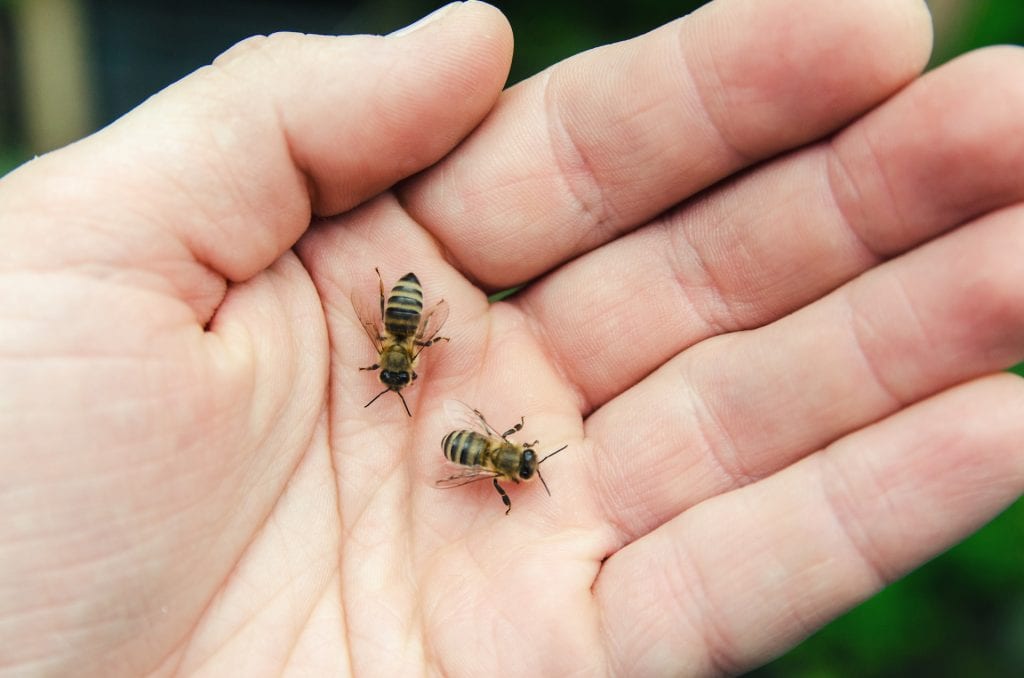How To Treat a Bee Sting

Let’s face it. A bee sting is never going to be the highlight of your day. For some, it’s just a painful nuisance. But for others who are allergic to bee stings, it can be much more than a nuisance–it can be life-threatening. The good news is that treating a bee sting can be as simple as opening your kitchen pantry. There are plenty of home remedies that can help reduce some of the unpleasant side effects of a honey bee sting.
What Happens When a Bee Stings You?
When a honey bee stings you, it releases bee venom into your skin through its stinger. The venom contains a compound called melittin which does a few notable things in your body. For one, it awakens pain receptors which cause the discomfort we feel after a bee sting. Melittin also triggers your body to release histamine which helps fight infections. Some side effects of histamine include swelling; thus, the swelling we experience after a sting.
Your first instinct may be to try to pull the stinger right out, but that is not usually the best choice. In fact, pulling the stinger out may cause even more of the venom to be released into your body. The best tactic is to gently remove the stinger by scraping it at an angle with your finger or even with a credit card.
Common Reactions to Bee Stings
As we mentioned earlier, most people will have some fairly mild symptoms after a bee sting. Although certainly not pleasant, common reactions include pain, redness, itching, swelling and warmth. For those who are allergic to bee venom, more severe reactions may occur such as hives, severe swelling, trouble breathing, nausea, dizziness or even loss of consciousness. If any of these more serious symptoms present, get medical attention right away.
How to Treat a Bee Sting
For your run-of-the-mill bee sting there are a number of at-home treatments that can help reduce the pain and swelling that you are experiencing. Many of these can be found in your kitchen pantry!
Here are some of the most common home remedies to treat a bee sting:
Honey
Funny how honey can actually help soothe honey bee stings! Honey has known anti-inflammatory properties and can help prevent infection. Applying a small amount of honey to your sting can help reduce the swelling and itching and prevent the sting from becoming infected.
Baking Soda
Mixing baking soda with water will create a paste that can be applied directly to the sting. This concoction will draw out bee venom and reduce pain. The mixture can be left on for 10 to 15 minutes before being rinsed off with warm water.
Apple Cider Vinegar
Apple cider vinegar has many healing properties. When applied to a bee sting, the vinegar can help draw out the bee venom. With this method, you can choose to soak a cloth in the vinegar and apply it to the bee sting for 15 to 20 minutes.
Witch Hazel
Witch hazel is a natural remedy for all kinds of skin issues and is known for soothing inflamed or irritated skin. Apply a cotton pad soaked in witch hazel directly to the sting to help reduce swelling.
Ice
Although not found in your pantry, ice is the go-to for reducing swelling. Icing the sting will not only reduce the swelling, but also the pain. Hold an ice pack on the sting for about 20 minutes and repeat as necessary.
Oils
There are several essential oils that are known to help reduce inflammation and prevent infections. Commonly used oils for bee stings include tea tree and lavender.
Live Bee Removal in San Diego
An occasional bee sting, especially in the summer months, is not uncommon. And unless you are allergic to bee venom, it is usually nothing to worry about. Try using some of these home remedies to treat your next bee sting and let us know how it goes!
If you are facing an unwanted hive that is causing problems for your family or neighbors, call D-Tek Live Bee Removal. We are the live bee removal experts, specializing in affordable and humane live bee removal and bee control in San Diego and North San Diego County. Contact us today for your free estimate.
